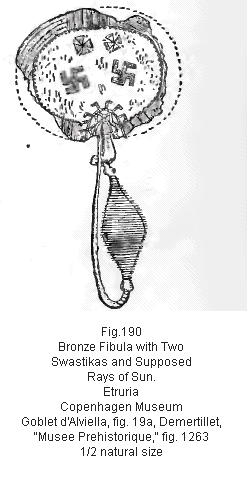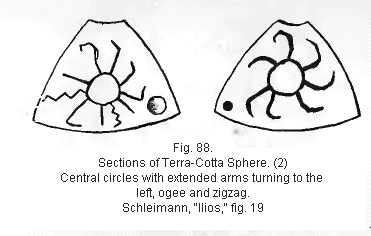

The Swastika
Definitions, Description & Origin
The author is more in accord with Dr. Brinton and others that the Swastika is derived from the cross and not from the wheel, that the bent arms do not represent rotary or gyratory motion, and that it had no association with, or relation to , the circle. This, if true, relieves the Swastika from all relation with the circle as a symbol of the sun. Besides, it is not believed that the symbol of the sun is one which required rotary or gyratory motion or was represented by it, but, as will be explained, in speaking of the Assyrian sun-god Shamash (. 789), it is rather by a circle with pointed rays extending outward.
D'Alviella (3) presents several figures in support of his contention. The first (a) is on a fibula from Etrnria (fig. 190 of this paper). His explanation is that the small circle of rays, bent at right angles, on the broad shield of the pin, represents graphically the rotary movement of the sun and that they bent arms in the Swastika on the same object are taken from them. It seems curious that so momentous a subject as the existence of a symbol of a great god, the god of light, heat, and thus of life, should be made to depend upon an object of so small importance. This specimen (fig. 190)
 is
a bifula or pin, one of the commonest objects of Etruscan, Greek, or Roman
dress. The decorations invoked are on the broad end, which has been flattened
to protect the point of the pin, where appears a semicircle of so-called
rays, the two Swastikas and two possible crosses. There is nothing about
this pin, nor indeed any of the other objects, to indicated any holy or
sacred character, nor that any of them were used in any ceremony having
relation to the sun, to any god, or to anything holy or sacred. His fig.
b is fig. 88 in this paper. It shows a quadrant of the sphere found
by Schliemann at Hissarlik. There is a slightly indefinite circle with
rays from the outside, which are bent and crooked in many directions.
The sphere is of terra cotta; The marks that have been made on it are
rough and ill formed. They were made by incision while the clay was soft
and were done in the rudest manner. There are dozens more marks upon the
same sphere, none of which seem to have received any consideration in
this regard. There is a Swastika upon the sphere, and it is the only mark
or sign upon the entire object that seems to have been made with care
or precision. His third figure (c) is taken from a reliquaire of
the thirteenth century A.D. It has a greater resemblance to the acanthus
plant than it has to any solar disk imaginable. The other two figures
(d and e) are tetraskelions or ogee Swastikas from ancient
coins.
is
a bifula or pin, one of the commonest objects of Etruscan, Greek, or Roman
dress. The decorations invoked are on the broad end, which has been flattened
to protect the point of the pin, where appears a semicircle of so-called
rays, the two Swastikas and two possible crosses. There is nothing about
this pin, nor indeed any of the other objects, to indicated any holy or
sacred character, nor that any of them were used in any ceremony having
relation to the sun, to any god, or to anything holy or sacred. His fig.
b is fig. 88 in this paper. It shows a quadrant of the sphere found
by Schliemann at Hissarlik. There is a slightly indefinite circle with
rays from the outside, which are bent and crooked in many directions.
The sphere is of terra cotta; The marks that have been made on it are
rough and ill formed. They were made by incision while the clay was soft
and were done in the rudest manner. There are dozens more marks upon the
same sphere, none of which seem to have received any consideration in
this regard. There is a Swastika upon the sphere, and it is the only mark
or sign upon the entire object that seems to have been made with care
or precision. His third figure (c) is taken from a reliquaire of
the thirteenth century A.D. It has a greater resemblance to the acanthus
plant than it has to any solar disk imaginable. The other two figures
(d and e) are tetraskelions or ogee Swastikas from ancient
coins. D'Alviella's next argument (4) is that the triskelion, formed by the same process as the tetraskelion, is an "incontestable" representation of solar movement.

ENDNOTES:
1. "La Migration des Symboles," chap. 2, pt. 3, p. 66. [Back]
2. Ibid., p. 67. H. Mis. 90, pt. 2-----50 [Back]
3. "La Migration des Symboles," p. 69. [Back]
4. Ibid., p. 71. [Back]
<< Previous Page Next Page >>
© 2004-2007 Northvegr.
Most of the material on this site is in the public domain. However, many people have worked very hard to bring these texts to you so if you do use the work, we would appreciate it if you could give credit to both the Northvegr site and to the individuals who worked to bring you these texts. A small number of texts are copyrighted and cannot be used without the author's permission. Any text that is copyrighted will have a clear notation of such on the main index page for that text. Inquiries can be sent to info@northvegr.org. Northvegr™ and the Northvegr symbol are trademarks and service marks of the Northvegr Foundation.

|